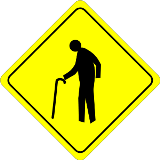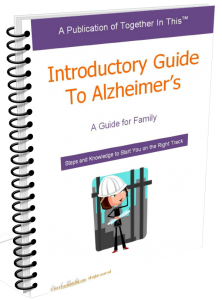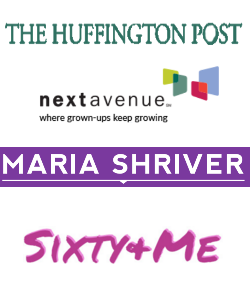
Caution, Old Dude
Assistive, cutting-edge technology geared for the Alzheimer’s care partnership is scarce. I’m really disappointed by the lack of involvement big companies seem to show when it comes to developing technology that is needed. The increased design complexity required for older adults and especially those with dementia tends to drive companies away. As a result, big companies tend to only stick their toes into the water due to the lower profit margins. Based on the lack of products, part of me believes they only do it for the publicity.
An underlying goal of mine at Together in This is to work with the dementia community to identify technological solutions that can be developed to help. My plan is to discuss concepts and listen to your feedback. I hope you will share your ideas and wishes along the way.
Technology can help
It won’t fix things, but it does have the potential to make things a little better. If designed properly, technology can help ease the pains of family caregiving while helping the care recipient remain safe, independent, and enriched.
 Categories for Alzheimer’s assistive technology
Categories for Alzheimer’s assistive technology
I believe that this technology falls into one of 4 categories:
1) Caregiver peace-of-mind,
2) Caregiver empowerment,
3) Patient empowerment, and
4) Patient enrichment
So let me share my view on these categories:
Caregiver peace-of-mind
Nobody has the time to devote 24 hours, 7 days a week to caregiving but we need the peace of mind to know that our loved one is safe and happy. Technology in this category primarily includes monitoring devices such as camera systems, GPS trackers, or fall detection devices. I like to refer to these technologies as “guardian” devices because they allow us to “keep an eye” on the care recipient. This also seems to be the area where most companies are focused.
Caregiver empowerment
The goal here is to empower the caregiver with the knowledge and tools to manage issues. This includes everything from legal documents to behavioral patterns. These technologies tend to take the form of software solutions such as a website, smart phone app, or a spreadsheet. Some solutions even help the care circle communicate events and issues to one another in a timely manner.
Patient Assistance

The patient needs to be empowered to be successful when performing activities of daily living (ADL). This is a tough area because there’s no “one size fits all” solution since every patient is so different throughout the stages of dementia. Moreover, the ability to learn is lost and they eventually go through a process of unlearning – the opposite of a child. Also, because of the added complexities associated with dementia, the human factors (ergonomics) associated with aging in place and activities of daily living are more involved.
Technology in this area is either passive or intelligent. This is definitely an area that I will elaborate on in upcoming articles. But for now, let me explain what I’m thinking.
A passive device is like the clock that displays that it’s Monday morning rather than showing the time of day or a pill box used to organize medications. The success of these products depends upon the care recipient’s ability to remember and/or rationalize the purpose of the device.
Intelligent solutions are continually being developed by the government and universities. These solutions, however, tend to be too complex and expensive to bring to the consumer market so we typically don’t see the benefit at home.
For an intelligent system to be useful with a demented patient, it must provide what I’ve coined as Computer Initiated Engagement (CIE). When we use a computer, we “engage” it. However, a person with special needs requires the computer to “engage” them. Even caregivers, who are in the throws of giving, need something to nudge (engage) them at times.
 These assistive, intelligent solutions can help augment the role of caregiver by providing unsolicited nudges, reminders, and comfort to the patient when needed. Imagine a system that can engage the patient, when needed, and adjust based on the patient’s emotions at the time. I truly think there is great potential in this area but to be able to come up with an affordable, adaptive system with CIE will be an expensive endeavor.
These assistive, intelligent solutions can help augment the role of caregiver by providing unsolicited nudges, reminders, and comfort to the patient when needed. Imagine a system that can engage the patient, when needed, and adjust based on the patient’s emotions at the time. I truly think there is great potential in this area but to be able to come up with an affordable, adaptive system with CIE will be an expensive endeavor.
I assume that we all have heard about the cool robots that perform this way but I’m not talking about robots replacing caregivers (that idea is so short sighted). In my opinion, these robotic solutions just aren’t practical or cost effective. Sure someday, everyone will have a personal robotic assistant but we need to simplify these ideas and make them affordable now.
 Patient Enrichment
Patient Enrichment
This is the area that gets me most excited. We must create purpose and help them achieve the things they can do and not focus on things they can’t. When they can no longer do purposeful things on their own, we must find ways to lift their spirit.
During the early stages, this involves helping them remain socially active for as-long-as possible and creating projects with purpose. During the later stages, enrichment comes through sensory stimulation and reminiscence techniques. All of this needs to occur without increasing the burden on the caregiver.
To reduce the burden on the caregiver and patient, the system must be somewhat “automagic”. And during the later stages of the disease, it needs to provide the ability to reminisce through music, pictures, and videos. It must also provide stimulation in other ways. I’m still working on how that will be possible but I have some ideas. Ideally, it will be able to determine their mood and adapt accordingly by using the latest emotion-detection software.
No matter how good the technology, at some point in the process of decline, there will always be a need for the caregiver to help. This personal interaction will always be the best enrichment of all because it touches our spirit in ways technology can’t.
Thank you for reading my synopsis on the 4 categories of assistive technology for the Alzheimer’s care partnership. Do you think I’m on track or not?
If you like what you’ve read, why not receive periodic updates when you:
Subscribe to the TinT Newsletter
Please share your thoughts with me in the comments section below so that we can fight this together, because we are all Together in This.





I think the “pads” of today could go a long way with the patient end; especially with early onset Alzheimer’. I know my wife’s aunt, who recently passed w/Alzheimer’s & COPD, loved puzzles online but as she started to lose her thought processes she would frustrate easily & then understand she couldn’t do it but not understand why. She passed before we could buy her a pad to download a child’s version of puzzles with larger & fewer pieces so she wouldn’t get frustrated. We did get her to play UNO, something she never played before Alzheimer’s but because of this we modified the rules. We helped her and we all put our cards DOWN so we could then see & help her (and each other so she thought this was ok). It kept her busy for a long period (for an Alzheimer’s patient). We had nothing like this when my mother had Alzheimer’s & I just feel like there is so much we could have done. I agree that with today’s technology someone has to realize the ability to sell 99 cent apps for people to download for their parents, loved ones, etc. with dementia.
I agree Richard so much that I even bought a couple of 22” tablets. These tablets have everything a 10” tablet has including touchscreen, camera, speakers, microphone, etc. They are made by ViewSonic and the model number is VSD220. You can find them on Amazon selling for under $350 (4 yrs ago the touchscreen alone was $3K). Any app that runs on Android will run on these. I’m hoping to have the opportunity to take them to one of the local memory care facilities to see how well residents engage with them. We can try things such as puzzles, finger painting, piano, videos from the past, music – you get the idea. I realize that some level of assistance is still required but my hope is to automate such a system so that the paid caregiver can float between more residents since the caregiver shortage is imminent. Or in the case of an at home caregiver, gain them some breathing room. Thank you for sharing
TrackibgCebtral has it’s CareTracker Watch that can report when the wearer enters or exits multiple zones. The watch also has an optional wrist locking mechanism.
The watch is a fully function gps tracking device allowing the wearers location to be tracked in real tine if the wearer wonders off or becomes lost.
The watch also has an SOS button that if pressed activates an SOS event alerting nominated others of the current location as well as activating a 2-way voice call to a nominated number
Locating a wearer of one of our CareTracjers can be acheived via our LiveTracking portal or our I-Phone App and or via email notifications.
We also have the ability to report alerts directly into Nurse Call systems so nursing staff can be alerted in real time of specific events allowing them to provide a prompt and timely response.
Our devices will work anywhere in the world where there is reliable mobile phone coverage.
For those of you in Australia reading this, TrackingCentral is a registered provider in the assisted technology category for the National Disability Insurance Scheme.
For more information visit http://www.TrackingCentral.com.au or call 1300 255 990
Thank you for sharing this information. After a brief look at your product line, it looks like your products offer a lot of benefit. Just a couple of days ago, someone told me they found a man wandering near a facility. When they helped the man back to the facility, the staff was shocked that he had gotten out. Your product could have prevented him from being lost in the first place. I will add your company to my list of products for review.
Hello, I know there are a number of technologies available to help remind persons with Alzhiemer’s (pwA) to take their medication – Phillips even has a dosing system that will recoup pills that are not taken within so many minutes of the alarm first sounding if pills are not taken from the unit and will then alert the designated caregiver to the missed dose. This seems to be a great idea for someone who is living independently and is compliant with taking their medications. It is a bit costly though. It’s an interesting start.
I also know of a parrot that responds to a persons voice (Pete the repeating parrot). What I wonder is if there is something that could combine these 2 concepts?
One thought would be to have a variety of animals available which could be set on a timer, like the meds are, and thus be used to trigger someone to do a particular activity (ie: a cat that meows and a caregivers or other pleasant voice prompts the pwA that it is time for meds or for lunch and that the cat would like to sit with him/her while he eats. Other prompts could be added customarily. Ideally, the cat (in this case) would also purr (or otherwise respond affectionately) when petted. It could also simply be programmed to meow at various times to request attention and/or (depending on the pwA level of receptiveness) could be programmed to speak/repeat (like the parrot does).
(Many who are not aquainted with pwA may scoff at an animal such as a cat talking, but look at any LTC unit which houses persons with advanced dementia and I’m sure you will notice dolls and other stuffed toys that residents confide in and care for regularly).
Furthermore; I know that many people, with or without dementia, find an increased sense of value and quality of life when they have some time to interact with an animal. Take a look at any retirement home with a visiting pet program – and, again, any LTC ward that houses pwA. The level of comfort and ability to confide in the pet or doll is real and is significant for those for whom this “therapy” works.
Anyhow….that’s just my 2 cents.
I’ve just discovered your site and plan to read it through entirely. It seems like a great resource. Thanks! Joanne B.
My second passion is animals, and bringing animals together with the pwA is something I really want to do. I also get it when you talk about the stuffed animals. If you remember Teddy Ruxpin (Google it if you don’t), he was a talking doll from probably 30 years ago. He would say, “I want to be your friend” or something similar. I had this written on my white board for months and it is a the core of what I call “companion technology.” I hope to be able to grow this site into something that will allow me to circle back to developing technology such as this.